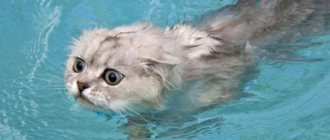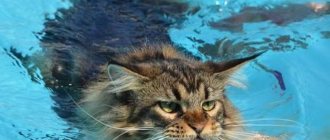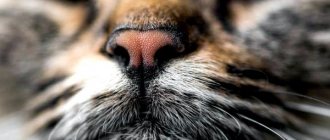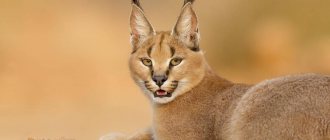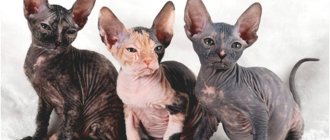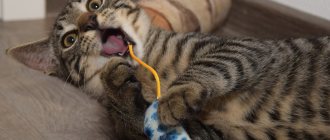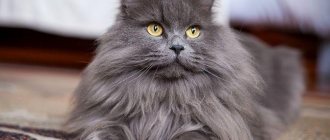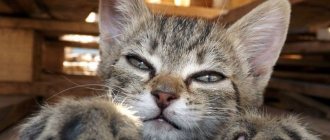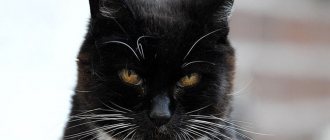Many lovers of mustachioed and tabby cats are interested in the question - what kind of cats love water and whether, in principle, there are such breeds that are loyal to swimming and water splashes. After all, one of the most established stereotypes about cats is their fear of water. Owners often prepare to bathe their furry friend as if they were going to a real war, seriously fearing that their affectionate and flexible pet will fight for the dryness of its fur coat as if it were the last frontier.
In fact, there are breeds of cats that, in principle, are not afraid to swim, and all other purrs can be accustomed to water procedures so that they, at a minimum, proceed calmly. Today we will talk about cats that like water, and also share the secrets of teaching cats to bathe.
What cats love water?
Maine Coon
Maine Coons are one of the largest domestic cats that are not afraid of water. Since their fur is waterproof, animals can withstand even low temperatures without harm to their health. However, Maine Coons' love of water has earned them a "dirty" reputation, as cats love to stick their paws in the toilet, figure out how the kitchen faucet works, or even dip their toys in dishes filled with water. Maine Coons are considered to be very intelligent, and their love of water stems from the breed's history of being used on warships to control rodents.
How to properly wash a cat?
It’s one thing to teach your pet to stand calmly in the water or even move around within the bathroom; it’s another thing to wash it. The preparation rules are the same - warm water is poured into a basin or bath in advance so as not to frighten the animal with the noise of the flowing water stream. Place a non-slip mat on the bottom. It is better to call a second person for help who can hold the animal while it is soaped and then the shampoo is washed off.
You can wet your cat and wash off the foam with a shower, choosing the weakest pressure
To wash cats, only specialized pet shampoos are used that do not dry out the pet’s delicate skin. You also need to have a small ladle on hand, with which you need to gently wet the animal. You need to talk to the cat kindly, holding it so that it does not slip or jump over the side of the bathtub.
Tips for choosing shampoo for a cat
The shampoo does not need to be immediately poured onto the animal, you need to warm it and foam it in your hands, and only then transfer it to the fur. Human movements should be light, massage, care must be taken to ensure that foam does not get into the eyes, and water does not get into the pet’s ears.
After the cat has been washed and the remaining shampoo has been washed off, you need to flush the bath and wrap the animal in a large towel or terry sheet. It will take some time for the fabric to absorb excess moisture. A wet cat should not be released on the floor so that it does not freeze and catch a cold in the draft. When the fur becomes barely damp, the pet can be licked.
Why most cats don't like water
If you look at immersion in water itself, as well as its consequences from the cat’s point of view, knowing some of the features of its physiology, then such behavior looks quite reasonable.
Violation of thermoregulation
Most cats, in addition to the guard hair of the coat, also have an undercoat. The undercoat is a large number of shorter and thinner hairs, often located, the main function of which is to retain air. Therefore, the cat is constantly surrounded by a layer of air at a temperature that is comfortable for it.
Cats' dislike of water is explained by the structure of their fur.
When the undercoat gets wet, the cat loses this air layer (and along with it the feeling of comfort) and does not see the opportunity to somehow improve its condition, since such a structure of the coat is its main means of thermoregulation. Only large wild cats can shake themselves off, removing excess water from their fur, as dogs do. Therefore, most cats try to prevent their fur from getting wet.
The instinct of self-preservation
The ancient instincts of a cat do not tell her to enter the water without special reasons for this.
The aquatic environment is not natural for cats
Staying in an aquatic environment requires additional effort for a cat - you need to constantly paddle with your paws so as not to drown; breathing is difficult; there is no support. The cat is the perfect hunter: quiet, swift and accurate; but being in an aquatic environment, she cannot use all these qualities and understands that she herself can become easy prey for a larger animal.
The smell of wet wool intensifies
After getting wet, the cat’s sebaceous glands intensify their work in order to quickly restore part of the secretion lost during bathing, covering the fur and skin with a thin layer and having a protective function. Some of the large sebaceous glands located in the chin and back of the body contain odorous substances, individual for each cat, which are used by it to mark the boundaries of its territory. Activation of the secretion of odorous secretion occurs simultaneously with increased activity of all sebaceous glands, since the glands form a single system. A strong smell unmasks a cat when hunting, and can also attract predators to it, so this is another good reason not to go into the water unless absolutely necessary.
Possibility of infection with infections and helminths
Wet fur retains a large amount of contaminants containing disease-causing pathogens - bacteria, protozoa, viruses and helminth eggs, which will inevitably fall into the cat's mouth when caring for contaminated fur.
Wet wool can harbor pathogenic bacteria.
This is a truly risky situation, the outcome of which depends on the state of the cat's immune system, and the cat instinctively seeks to avoid it.
Stressful state
Each pet is an individual with its own opinion and personal boundaries. This is especially true for cats, which are highly valued for the combination of independence and sincerity in their character. It is almost impossible to force a cat to do anything under duress. And when a cat, against his will, is roughly dipped into a container of liquid, he experiences real stress, since everything that happens is perceived by him as inappropriate behavior on the part of a person. The cat is used to taking care of his fur on his own and is confident that he does a good job of it; he does not see any hygienic advisability in water procedures.
Don't be rough with your cat when bathing.
But, unfortunately, people rarely take into account that their pets have their own individuality, and the use of violence against them is not considered barbaric, although this does not change the essence of the phenomenon.
Unpleasant shampoo odors
An additional factor that turns a cat away from water procedures will be the use of detergents with a smell that is pleasant to the human sense of smell. The sensitivity of a cat’s sense of smell is many times greater than that of a human, and humans and cats also have distinct differences in the subjective perception of “pleasantness-unpleasantness” of odors.
Cats need to be washed with shampoos made specifically for them.
In addition, detergents for humans are too aggressive for animal skin and dry it out.
A wet fur coat is taboo
The distant voice of ancestors whispers clues where animals have no experience. One of these instincts explains why cats are afraid of water - they simply sense the troubles emanating from it.
Even if Murka has never swam, genetic memory dictates to retreat before the blue element:
- The need to lick yourself after bathing will take a lot of time and distract you from observing your surroundings, which is life-threatening. And if you have to get wet in a musty swamp, washing your face will also be disgusting.
- Sunstroke due to wet fur is a good reason why cats don't like water. Thanks to the air cushion at the roots, the thick, dry wool perfectly protects against temperature changes. When wet, a fur coat loses this property. In nature, dogs have much less hair, and their thermoregulation is worse. But they can breathe with their tongue hanging out to cool themselves. Cats can’t do that, and therefore they quickly overheat.
- The risk of hypothermia due to a wet fur coat also does not add to the desire to swim. The dog cuddles up to its fellow tribesman or simply runs around to dry out. A cat's thicker coat will not dry out from running around, and he will not make so much noise. Without sentinels and the protection of fellow tribesmen, you have to behave secretly. This means that the wool will take a long time to dry, which is dangerous for health in the cold season.
- The smell of wet wool intensifies many times over. As the moisture evaporates, it spreads the characteristic amber around. Not wanting to give yourself away is a very powerful instinct that explains why cats don't like water. The strong smell will certainly attract predators and betray it to prey.
- Bacteria, fungi and other microflora multiply quickly in a warm, humid environment. In cool weather, thick fur will remain damp at the roots for several days, which can lead to infection.
Cat breeds with the most affectionate and calm personalities
Peace and tranquility in the house depend on the character of the pet. The affectionate and balanced cat spends his evenings in a chair with his owner, is loyal to children, and does not conflict with other animals.
Ragdoll
If you ask which cats are the most affectionate and calm, then you cannot find a better ragdoll breed. The name of the breed is translated as “rag doll”.
A large, but cute and clumsy pet, which was obtained by crossing Burmese and Angora cats, is absolutely devoid of aggression and the hunting instinct, and allows itself to be squeezed like a toy. The Ragdoll is kind, balanced, flexible, not talkative, and needs constant contact with its owner.
Shorthair exotic
A stocky cat with a flat nose and a touching expression on his face is popular all over the world. The breed is friendly, playful, and devoid of aggression. The pet needs the constant presence of a person, willingly participates in children's amusements, gets sick from loneliness and separation from its beloved owner, and has difficulty adapting to a changed environment.
Shorthair exotic
Russian blue cat
A sweet, affectionate, friendly pet readily communicates with children, treats guests with confidence, and gets along with a dog if it grew up with one from an early age. But the breed cannot be called affectionate.
The Russian cat easily tolerates short-term loneliness, does not like changes in environment, plays with the child whenever she wants, and is characterized by territorial behavior and restraint in showing emotions.
Maine Coon
Large native cat from the USA. Despite his harsh appearance, he is affectionate, flexible, intelligent, and amenable to training. The pet subtly senses the inner state of a person, is always open to communication, is friendly towards all household members, and does not shy away from guests.
Favorite pastime is sitting on the owner's lap. The attitude towards children is neutral, but it is better not to have a large cat with a developed hunting instinct for a family with a baby.
Burmese cat
In the photo, the Burmese looks graceful, willful, freedom-loving, a real predator. In fact, the breed has a gentle, sociable, cheerful character. The cat, infinitely devoted to its owner, tries to always be nearby, even sleep near the owner’s bed.
Burma loves to purr, looking into the owner's eyes, and the quiet and gentle voice of the cat calms and relieves stress.
Oriental
The description of the cat’s appearance is very exotic: huge ears, a narrow muzzle, an elongated and lean “oriental” build. Orientals are loved not only for their external originality, but also for their wonderful character.
The pet is non-aggressive, affectionate, non-offensive, talkative, friendly and trusting towards guests. Loves to play active games.
Siberian cat
Despite their autonomy and independence, “Siberians” become strongly attached to their owner and willingly participate in children’s games. The breed attracts with its balance, tact, intelligence, and spontaneous behavior. The cat is quiet and hardy.
Siberian cat
Sphinxes
Several varieties of Sphynxes have been bred, and all of them can be called the most tame cat breeds. The naked cat loves his owner immensely, loves to sit in his arms, and warm himself under a warm blanket in the owner’s bed. But it does not impose itself when the owner is busy.
Sphinxes lack aggression, are not touchy, and treat guests with trust. They react loyally to children's pranks and coexist peacefully in the apartment with other animals.
Persian cat
The breed is loved not only for its aristocratic manners and luxurious appearance, as can be seen in the photograph, but also for its kind, calm, affectionate character. “Persian” is phlegmatic, stubborn, plays according to his mood, prefers to lie on his master’s lap, and is indifferent to children and other animals.
He responds to love and kindness with endless devotion. The breed is in demand, widespread, the price of a purebred kitten is up to 30 thousand rubles.
Scottish fold cat
Phlegmatic, calm, sweet. He doesn’t intrude, he can spend hours watching a person go about his business. She is restrained in her expression of emotions, does not tolerate squeezing and noise, but becomes strongly attached to her owner and greets him at the door from work.
“Scotsman” is a good companion for a lonely person who does not like noisy gatherings.
Manx
A tailless cat breed with plush-feeling fur. The complete absence of a tail is observed in the best individuals. Manx grow very quickly, have average activity, but love to play, have strong hind legs, jump well, and love to climb high places in the house.
They love water, play with streams of water, and watch water from the tap. They can swim with their owner in the lake or even in the bathtub. It is not recommended to bathe Manx cats frequently, so as not to wash off the protective layer on the coat. During bathing they behave without whims.
Japanese Bobtail
The long-legged cat with a muscular body looks like a powerful predator. A distinctive feature is a small tail, like a rabbit's. An energetic, impatient cat who loves to hunt, he is friendly in the family. There are long-haired and short-haired breeds.
They treat water very well, bathing in the bathtub or in the river brings pleasure to this breed, but bathing more than once every three months is not recommended; the cat takes care of its hygiene on its own. When bathing, you need to be very careful with the cat's tail, because it is a vulnerable part of the body.
Abyssinian cat
Smooth-haired breed of royal blood. A stately gait and defiant gaze only indicate that cats have a noble, calm character. These are companion cats, helpers, friends. They have a playful character and get along well with children. They are very curious and want attention.
The coat is short, so frequent bathing is recommended only during shedding. They treat water well, and the four-legged friend does not leave a playful mood while swimming.
Vega
The Norwegian Forest Cat may be your family's favorite cat. Friendly, affectionate, very playful, covered with thick water-repellent fur, with a large fur collar, has a hunting instinct. If you have an aquarium in your house, then it can catch fish.
The breed is very energetic and hardy; it loves not only to swim in the lake, but also to fish there. He is not afraid of rain, loves water, so he takes swimming very well. The wool is washed with a special shampoo and conditioner.
Dislike of water
Basically, cats don't like water. This is due to the fact that their ancestors lived in desert areas, and swimming was unusual for them. The second reason is that the wool gets wet. It becomes heavy and sticks to the skin. The cat feels extremely uncomfortable. He seems to be left without a protective shell, so he feels helpless. You've probably seen a picture where a pet, after bathing, hides in a corner and becomes quiet and unnoticeable until the fur dries.
What you need and what you don’t need to do while bathing
Before the procedure, veterinarians recommend thoroughly combing the cat and removing tangles. Then insert cotton balls into your pet's ears or put a special cap on his head. After this, the massage mitten is moistened in water, and a detergent is applied to its surface. After foaming, the shampoo is gently rubbed into the animal’s fur with massage movements. There is no need to press hard, otherwise it will scare the animal even more, and then it will be much more difficult to restrain it.
Bathing a cat in a basin
If you are planning to bathe your cat in a basin, then place it in the bathtub. It is better to line the bottom of the basin with a terry towel or rug so that the cat does not slip. The room in which bathing takes place must be cleared of foreign objects, otherwise they risk ending up in the bathtub (basin) or, worse, on the cat’s head.
Water is also important when bathing an animal. Its temperature should not exceed 40°C and be at least 36°C
Veterinarians pay attention to the proper water level. It should not be higher than the level of the pet’s stomach
Therefore, there is no need to fill the bathtub (basin) to the top. If the cat does not feel the bottom under his paws, this can greatly frighten him.
Thermometer for measuring water temperature (without mercury)
Be sure to trim the animal’s claws before the procedure.
It is very important. This way you will protect yourself from possible scratches and damage.
There should be no loud sounds, screams, or pressure. Try to be calm and affectionate.
It is more convenient to bathe a cat together. Immediately assign roles - who will hold the animal and who will bathe it. It is better to entrust the bathing process to the person the cat loves most.
Why do dogs love to swim so much, unlike cats?
This can be explained by several facts. The structure of a dog's fur is different from that of a cat's; as a rule, it is thinner and longer, and water drains easily from it. Dogs carefully shake off their fur when leaving the water. Also, in dogs, thermoregulation is additionally regulated by breathing activity. If it's hot, the dog sticks out its tongue and breathes quickly.
A dog’s specific smell is present even when the coat is dry, so getting it wet doesn’t really change anything. Dogs by nature are pack animals and hunt by stalking rather than tracking prey. And they are not particularly afraid of predators; they are unlikely to suddenly attack an entire flock.
Some people love to keep company with the owner while he is taking a shower, while others like to cool off under the stream of water pouring from the tap. Often these are breeds such as: Bengal cats, Siamese, Somalia, Orientals, Thais, Turkish Vans, Angoras, Sphynx, Rex, Kuril Bobtails, Savannahs, Abyssinians.
Bengal cat
Show class cat breed. Very active, playful, constantly purring. They do not show aggression, play actively with children, and treat guests with caution. A highly developed intelligence obliges owners to constantly purchase new puzzle toys for their pets. Bengals are large in size, resemble wild cats in appearance, are graceful, flexible, have a spotted color, and short silky hair.
They simply adore water with a real passion; they love to splash in the water and play with toys in it. Frequent bathing is not recommended, but at exhibitions it is mandatory to use shampoos and conditioners to keep the coat beautiful. Cats love to bathe with their owners, but you should not overdo this activity so as not to wash off the protective layer from the skin and fur.
